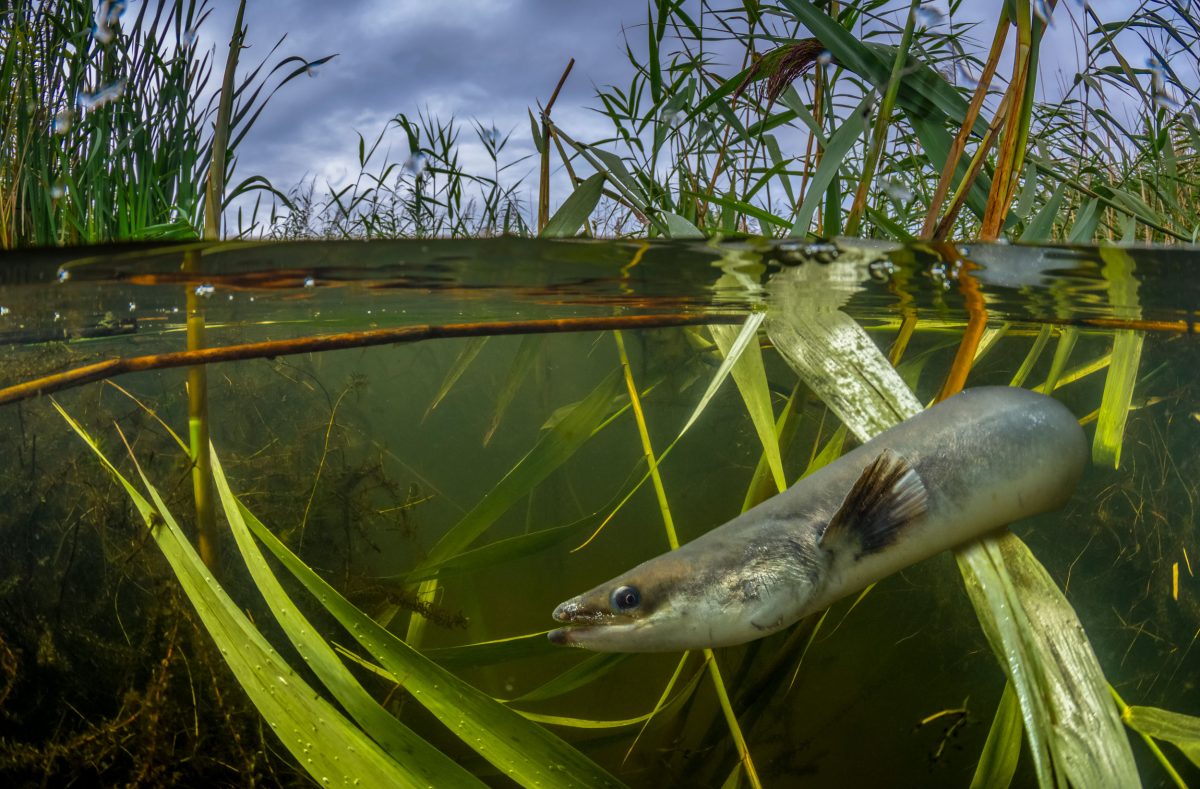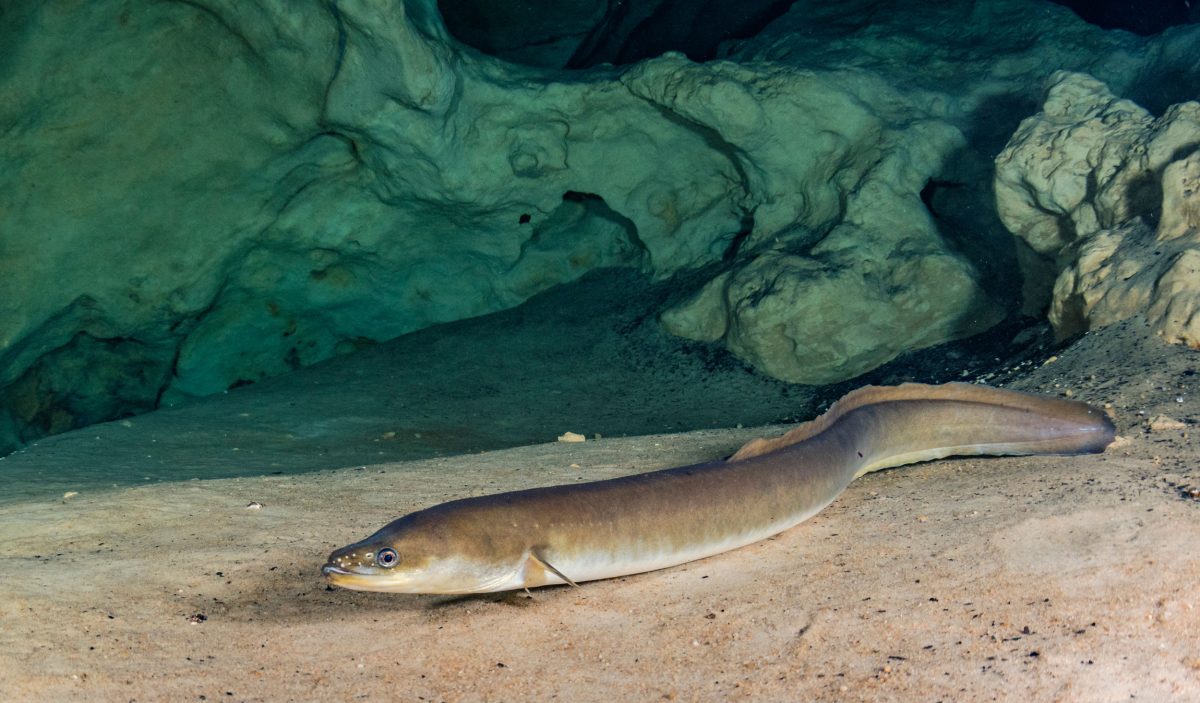
What I think is that the eel became established well before hte atlantic opened up or at least contempraneous when it was a rift valley. I also think that the non existent Giant Sea Serpent also participated in the process. Both likely take full advantage of the Sargasso Sea. I wonder if the Pacific Sea Serpents make it to the Sargasso?
It would be amusing if the giant Sea Serpent belonged to the EEL family. why not, already?
That actually solves all sorts of problems looking at a reptillian linage. Terraforming Terra will end up been eel friendly as wetlands are intensely productive when fully mastered and managed. We have barely begun there.
The Mysterious, Vexing, and Utterly Engrossing Search for the Origin of Eels
To save endangered eels, researchers have been working for decades to figure out where they reproduce.
September 13, 2022 | 2,200 words, about 11 minutes
https://hakaimagazine.com/features/the-mysterious-vexing-and-utterly-engrossing-search-for-the-origin-of-eels/?ref=refind
This article is also available in audio format. Listen now, download, or subscribe to “Hakai Magazine Audio Edition” through your favorite podcast app.
Every three years, Reinhold Hanel boards a research ship and voyages to the only sea in the world that’s located in the middle of an ocean. The Sargasso, bounded by currents instead of land, is an egg-shaped expanse that takes up about two-thirds of the North Atlantic, looping around Bermuda and stretching east more than 1,000 kilometers. Dubbed the “golden floating rainforest” thanks to the thick tangles of ocher-colored seaweed that blanket the water’s surface, the Sargasso is a slowly swirling sanctuary for over 270 marine species. And each year, the eels arrive.
The European eel and the American eel—both considered endangered by the International Union for Conservation of Nature—make this extraordinary migration. The Sargasso is the only place on Earth where they breed. The slithery creatures, some as long as 1.5 meters, arrive from Europe, North America, including parts of the Caribbean, and North Africa, including the Mediterranean Sea. Hanel, a fish biologist and director of the Thünen Institute of Fisheries Ecology in Bremerhaven, Germany, makes his own month-long migration here alongside a rotating cast of researchers, some of whom hope to solve mysteries that have long flummoxed marine biologists, anatomists, philosophers, and conservationists: What happens when these eels spawn in the wild? And what can be done to help the species recover from the impacts of habitat loss, pollution, overfishing, and hydropower? Scientists say that the answers could improve conservation. But, thus far, eels have kept most of their secrets to themselves.
The idea that eels have sex at all is a fairly modern notion. Ancient Egyptians associated eels with the sun god Atum and believed they sprang to life when the sun warmed the Nile. In the fourth century BCE, Aristotle proclaimed that eels spontaneously generated within “the entrails of the earth” and that they didn’t have genitals.
The no-genital theory held for generations. Roman naturalist Pliny the Elder asserted that eels rubbed against rocks and their dead skin “scrapings come to life.” Others credited eel provenance to everything from horses’ tails to dew drops on riverbanks. In medieval Europe, this presumed asexuality had real economic consequences and helped make the European eel a culturally important species, according to John Wyatt Greenlee, a medieval cartographic historian who wrote part of his dissertation on the subject. Frequent Christian holidays at the time required followers to adhere to church-sanctioned diets for much of the year. These prohibited adherents from eating “unclean” animals or meat that came from carnal acts, which could incite, as Thomas Aquinas put it, “an incentive to lust.” Fish were the exception, Greenlee says, and eels, given their abundance and “the fact that they just sort of appear and that nobody can find their reproductive organs at all,” appealed to anyone trying to avoid a sexy meal.

As catadromous creatures, European and American eels spawn in marine waters and then swim to fresh water—like this wetland in England—to live. Photo by Neil Aldridge/Minden Pictures
Eels could be practically anything to anyone: dinner or dessert; a cure for hangovers, drunkenness, or ear infections; material for wedding bands or magical jackets. They were even used as informal currency. Since yearly rent and taxes in medieval Europe were often due during Lent—the roughly 40-day period preceding Easter—and monasteries owned land people lived on, tenants sometimes paid with dried eels. Entire villages could pay 60,000 eels or more at once.
Eventually, spontaneous generation theories died. But eel genitals landed in the spotlight again after an Italian surgeon found ovaries in an eel from Comacchio, Italy, and the findings were published in the 18th century. The legitimacy of the so-called Comacchio eel remained in question for decades until an anatomist published a description of ovaries from a different Comacchio eel, launching a race to find testicles. Even the granddaddy of psychosexual development theory got involved: near the beginning of his career, in 1876, Sigmund Freud dissected at least 400 eels in search of gonads. It would be about another two decades before someone discovered a mature male eel near Sicily.
It’s no surprise that it took so long to find eel sex organs. There are more than 800 species, about 15 of which are freshwater varieties, and their bodies change so dramatically with age that scientists long thought the larvae were a different species than adult eels. Eels transform from eggs to transparent willow-leaflike larvae, to wormy see-through babies called glass eels, and onward until full size. Like most eel species, American and European eels don’t fully develop gonads until their last life stage, usually between 7 and 25 years in. Around that time, they leave inland fresh and brackish waters, where people can easily observe them, and migrate up to about 6,000 kilometers—roughly the distance from Canada’s easternmost tip to its westernmost—to the Sargasso.

Born by the billions in the Sargasso Sea, eels start as larvae, grow into transparent, threadlike glass eels, and then opaque, dark brown-gray elvers, before settling into middle-aged yellow eels. Eels reach maturity between the ages of four and 18. Photo by Nick Upton/Minden Pictures
By now, researchers have seen eels mate in lab settings, but they don’t know how this act plays out in the wild. The mechanisms that guide migration also remain somewhat enigmatic, as do the exact social, physical, and chemical conditions under which eels reproduce. Mature eels die after spawning, and larvae move to freshwater habitat, but when that happens and how each species finds its home continent are also unknown.
“We think that the European eel reproduces in the Sargasso Sea because this is the place where we have found the smaller larvae, but we have never found a European eel egg or the eels spawning,” says Estibaliz Díaz, a biologist at AZTI marine research center in Spain, who studies European eel population dynamics and management. “It’s still a theory that has not been proven.” The same applies to the American eel, and yet more questions remain about how many eels survive migration, what makes the Sargasso so singular, and how factors like climate change might affect it.
Both species have dropped in number, but researchers debate which threat is the biggest. Habitat loss is huge—humans have drained wetlands, polluted waters with urban and agricultural runoff, and built hydropower turbines that kill eels and dams that block the animals from migrating in or out of inland waters. Fishing further reduces eel numbers. Commercial fisheries for adult eels exist, but most eels consumed globally come from the aquaculture industry, which pulls young glass eels from the wild and raises them in farms. American and European eels are among the top three most commercially valuable species alongside the Japanese eel, which is also endangered. While it’s legal to fish for all three, regulations on when, where, and how many eels can be sold vary between countries. The European Union requires member nations to close their marine fisheries for three consecutive months around the winter migration season each year—countries themselves determine exact dates—and prohibits trade outside of member countries, but these management efforts are undermined by black-market traders who illegally export more than 90 tonnes of European eels to Asia every year.
The International Union for Conservation of Nature (IUCN) lists European eels as critically endangered—populations have plummeted more than 90 percent compared with historical levels, and it’s “rather unclear,” as one report notes, whether the decline continues today. By counting glass eels in estuaries and inland waters, researchers found that eel numbers dropped precipitously between the 1980s and 2011, but plateaued afterward without clear cause. American eels are thought to be faring better—they’re considered endangered only by IUCN standards, not by other conservation and research groups—though their numbers have also decreased since the 1970s.
Captive breeding might one day reduce the aquaculture industry’s dependence on wild catches, but isn’t yet viable. Scientists must induce eel gonad development with synthetic hormones. It’s also hard to keep larvae alive. Many researchers believe that, in their natural habitat, larvae eat marine snow—a mélange of decaying organic matter suspended in the water that is impractical to reproduce at commercial scales. Illuminating what happens in the Sargasso could help guide better conservation measures. That’s why Reinhold Hanel heads to sea.
After three years of COVID-19-related delay, in 2023, Hanel will send a research vessel on a 14-day trip from Germany to Bermuda. He’ll fly there and meet up with 11 other eel researchers, then he’ll spend about a month slowly traversing the southern Sargasso, recording ocean conditions, trawling for eel larvae with mesh plankton nets, and sampling for environmental DNA—genetic material shed from skin, mucus, and poop—to track eels by what they leave behind.
Hanel has led voyages like these since 2011. His main goal is to document the abundance of larvae and young eels and, secondarily, to identify possible locations for spawning. By sampling estuaries and inland waters, researchers can identify trends over time to figure out if glass eels in continental waters are increasing or not, but without comparing those trends with similar ones in the Sargasso, it’s impossible to judge whether either American or European eels are bouncing back. Meanwhile, protective regulations aren’t enough, Hanel contends. In 2007, the European Union mandated that member countries develop European eel recovery plans, but several prominent fishery and marine science organizations have criticized the particulars.

Reinhold Hanel is head of the Thünen Institute of Fisheries Ecology in Germany. Photo by Carmen Jaspersen/dpa/Alamy Stock Photo
In tandem with other measures aimed at reducing eel mortality, provisions like closing fisheries make sense, Hanel says—last year, an international consortium of researchers, of which Hanel is a member, recommended closing fisheries until glass eel stocks recover. But other requirements aren’t rooted in research, including one to ensure 40 percent of adult eels survive to migrate from inland waters to the sea each year. “Scientists cannot say if 40 percent is sufficient to recover the stock,” Hanel says.
That’s why Hanel’s work is so important, says Martin Castonguay, a marine biologist and scientist emeritus at Fisheries and Oceans Canada, who has collaborated with Hanel. Financial obstacles often prevent eel scientists from conducting research outside of inland waters. Research vessels can cost anywhere from CAN $30,000 to $50,000 per day, or just under $1-million for a month-long trip, Castonguay says, requiring scientists to have hefty grants or government support to venture all the way to the Sargasso.
Despite the barriers, scientists keep trying to find answers to how to help eels recover. They have planted hydroacoustic devices in hopes of tracking migrating eels by sound, pored over satellite photos, and injected eels with hormones to induce gonad development before releasing them into the Sargasso to try to study how deep beneath the surface they spawn. Back at home in the lab, they’ve developed algorithms to scan for and spot eels in sonar images of inland waters and built hyperbaric swimming tubes to observe how eels respond to changes in pressure and current strength. They’ve even tried to follow them with satellite transmitters.
In the mid-2010s, Castonguay and four other researchers sewed buoyant trackers to 38 American eels and released them off the coast of Nova Scotia. Every 15 minutes, the trackers recorded the depth at which the eels were swimming, the water temperature, and light levels. The sensors were designed to detach several months later and transmit the data along with the eels’ final location. Unfortunately, they detached before the eels reached any specific spawning locations, though one eel got as close as 100 to 150 kilometers from the spawning region. Still, “it was the first time that an [adult American] eel was documented in the Sargasso,” says Castonguay. Previously, only larvae had been found there. “We were extremely excited.”

American eels—above—are found in fresh waters from Greenland to Venezuela. The European eel and the American eel are both considered endangered by the International Union for Conservation of Nature. Photo by Shane Gross/Minden Pictures
If more governments and research institutions were willing to spend the resources, Castonguay adds, these eels wouldn’t be so mysterious. Research on a similar species in Japan offers a case study for how that could work.
On the other side of the globe from the Sargasso, the Japanese eel makes a 3,000-kilometer annual migration from Japan and surrounding countries to the West Mariana Ridge in the western Pacific Ocean. With support from the Japanese government and other scientific institutions, researchers there have identified a spawning location, collected fertilized eggs, and tracked tagged eels swimming to their spawning area—all feats never attained in the Sargasso. They’ve found that Japanese eels spawn over a period of a few days before the new moon, at depths of 150 to 200 meters, and that spawning is triggered in part by temperature shifts that happen as eels move from deep to shallower water. Some eels, they learned, might spawn more than once during a spawning season.
Public outreach efforts have also been important, says University of Tokyo eel biologist Michael Miller. The researcher who led most of the eel work, Katsumi Tsukamoto—a University of Tokyo scientist emeritus known as Unagi Sensei, or Dr. Eel—has worked hard to raise the eels’ public profile. His findings have helped build the case that eels are “something other than just a meal,” Miller says. “It’s something [that’s] part of the Japanese culture and it’s worth conserving,” which has helped boost efforts to protect them.
Hanel is trying to do the same for the eels of the Sargasso and for other species. He speaks to the press and the public as often as he can. He believes, as many others do, that successfully conserving these creatures hinges on whether there’s a unified international effort to do so. But so long as data snapshots come only every few years, answers to questions about spawning and species well-being will stay hidden somewhere in the watery depths, just like the eels themselves.
No comments:
Post a Comment